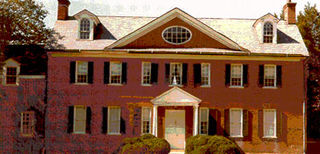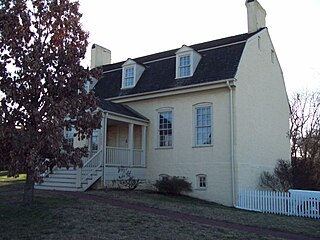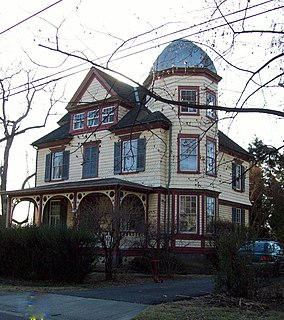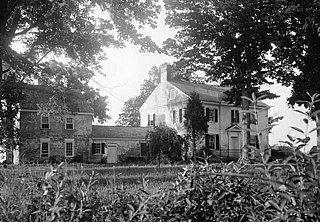
The Thomas Stone National Historic Site, also known as Haberdeventure or the Thomas Stone House, is a United States National Historic Site located about 25 miles (40 km) south of Washington D.C. in Charles County, Maryland. The site was established to protect the home and property of Thomas Stone, one of the 56 signers of the United States Declaration of Independence. His home and estate were owned by the Stone family until 1936.

The Belair Mansion, located in the historic Collington area and in Bowie, Maryland, United States, built in c. 1745, is the Georgian style plantation house of Provincial Governor of Maryland, Samuel Ogle. Later home to another Maryland governor, the mansion is listed on the National Register of Historic Places.

Located south of Laurel in Prince George's County, Maryland, United States, Montpelier Mansion is a five-part, Georgian style plantation house most likely constructed between 1781 and 1785. It has also been known as the Snowden-Long House, New Birmingham, or simply Montpelier. Built by Major Thomas Snowden and his wife Anne, the house is now a National Historic Landmark operated as a house museum. The home and 70 acres (28 ha) remain of what was once a slave plantation of about 9,000 acres (3,600 ha).

Harmony Hall, located in Fort Washington, Maryland, is managed by the United States National Park Service as part of the National Capital Parks-East system. It has been a National Park Service site since 1966. Harmony Hall is a 2+1⁄2-story Georgian country house built of red brick during the eighteenth century. It is surrounded by 65 acres (26 ha) of land on Broad Creek, a Potomac River tributary.

His Lordship's Kindness, also known as Poplar Hill, is a historic plantation estate on Woodyard Road east of Clinton, Maryland. It was built in the 1780s for Prince George's County planter Robert Darnall. The five-part Georgian mansion retains a number of subsidiary buildings including a slave's hospital and a dovecote. The property is now operated as a museum by a local nonprofit preservation group. It was designated a National Historic Landmark in 1970.

Bostwick is a historic home located a short distance below Lowndes Hill, the present-day property of Bladensburg Elementary School in Bladensburg, Prince George's County, Maryland, United States. According to its date plaque, it was built in 1746 by Christopher Lowndes (1713-1785). The house was later the home of Lowndes’ son-in-law, Benjamin Stoddert (1751-1813), first Secretary of the Navy. Colonel Thomas H. Barclay resided at "Bostwick," the oldest surviving structure at Bladensburg. Located nearby is the Market Master's House, also built by Lowndes.

The William Hilleary House, or Hilleary-Magruder House, is a historic home located at Bladensburg in Prince George's County, Maryland, United States. The house is the only 18th-century stone, gambrel-roofed house in Prince George's County. It is now surrounded to the south and west by an exit ramp connecting Kenilworth Avenue with Annapolis Road.

Ash Hill, or Hitching Post Hill, is a two-story brick dwelling erected ca. 1840, and located on Rosemary Lane, in Hyattsville, Prince George's County, Maryland. The house was built by Robert Clark, an Englishman who was seeking space and quiet in contrast to the crowded city of Washington, D.C. In 1875, General Edward Fitzgerald Beale bought the property. Beale was well connected and known to have entertained President U.S. Grant, President Grover Cleveland and Buffalo Bill Cody. The house, with its foot-thick brick walls and hilltop site, is an imposing one, made even more so by the massive pillared porch which surrounds it on three sides. The porch was added by Admiral Chauncey Thomas who purchased the property in 1895.

Compton Bassett is a historic home in Upper Marlboro, Prince George's County, Maryland, United States, that was constructed ca. 1783. It is a two-story brick Georgian house, covered with cream-colored stucco, on a high basement of gray stucco. A two-story wing was added in 1928. Remaining outbuildings include a chapel to the southeast, a meat-house to the southwest, and a dairy to the northwest. Also on the property is a family burial ground.

The John W. Coffren House and Store are two historic buildings located at Croom in Prince George's County, Maryland. This assemblage is significant for their architecture, as well as their association with the commercial history of the area and with John W. Coffren, local merchant and landowner. The Coffren House, built in 1861, has a Greek Revival entrance and interior detail. The Coffren Store, constructed ca. 1853, is a utilitarian structure, designed for use as a one-room general store. The store closed in 1945. The significance of the house and store together is that they are an intact example of house and store complexes that served rural communities in the county during the 19th century. Their builder, John W. Coffren (1828-1874), who rose from ditch digger to wealthy merchant, served on the Vestry of St. Thomas Church in Croom and on the Prince George's County School Board, as well as owning much of the property in the Village of Croom.

The Cottage is a 19th-century plantation complex located near Upper Marlboro in Prince George's County, Maryland. The complex consists of the principal three-part plantation house with its grouping of domestic outbuildings and four tenant farms, scattered over 282 acres (114 ha). The plantation house has a 2+1⁄2-story main block constructed in the 1840s with a typical Greek Revival style interior trim and distinctive Italianate cornice brackets. Within 150 feet (46 m) to the northwest of the house is a complex of domestic outbuildings, including a well house, ice house, and meat house. It was the home of Charles Clagett (1819–1894), a prominent member of Upper Marlboro social and political society during the second half of the 19th century. He served as a county commissioner following the Civil War.

Hazelwood is a historic home located outside Upper Marlboro, Prince George's County, Maryland, United States. The home is a large asymmetrical frame dwelling, built in three discrete sections over a long period of time. They are: a low gambrel-roofed section dating from the 18th century, about 1770; a gable-roofed Federal-style dwelling dating from the very early 19th century; and a tall gable-front Italianate-style central section constructed about 1860. The house stands on high ground west of and overlooking the site of historic Queen Anne town on the Patuxent River. Also on the property are several domestic and agricultural outbuildings, and the reputed sites of two cemeteries.

Kingston, or Sasscer's House, is a 1+1⁄2-story historic home located at Upper Marlboro, Prince George's County, Maryland, United States. It is believed to be the oldest building remaining in the town of Upper Marlboro and may have been built, at least in part, before 1730. Many alterations and additions were made to it in the Victorian era, including "gingerbread" details typical of this era. The Craufurd family cemetery is located in the woods northwest of the house.

Oxon Hill Manor is a neo-Georgian house of 49 rooms, located at Forest Heights, Prince George's County, Maryland. It was designed in 1928 for Sumner Welles (1892-1961) by the Washington architect, Jules Henri de Sibour (1872-1938). It was built in 1929, and consists of a two-story main block of Flemish bond brick and a northern wing. Also on the property are two outbuildings contemporary with the house; a five-car garage and attached manager's quarters and greenhouse, and a stable. There are also formal gardens on the grounds.

The Harry Smith House is a Queen Anne-style frame dwelling, built in 1890. It stands on one of the original streets platted in the 1889 railroad suburb subdivision of Riverdale Park, Prince George's County, Maryland located northeast of Washington, D.C. The home is representative of the transition in domestic architecture between the Queen Anne style of the 1880s and the popular plan of the turn of the 20th century. Its owners were a middle class, government worker family, the Smiths, who owned it from the time when the developer sold it until the middle of the 20th century.

Mount Airy, also known as Grove Farm, is a historic home located at Sharpsburg, Washington County, Maryland, United States. It is a 2+1⁄2-story Flemish bond brick house, built about 1821 with elements of the Federal and Greek Revival styles. Also on the property are a probable 1820s one-story gable-roofed brick structure that has been extensively altered over time, a late-19th-century frame barn with metal roof ventilators, a 2-story frame tenant house built about 1900, and a mid-20th-century cinder block animal shed. It was used as a hospital for Confederate and Union soldiers following the Battle of Antietam. On October 3, 1862, President Abraham Lincoln and General George McClellan visited Mount Airy, an event recorded photographically by Alexander Gardner.

Mount Harmon is an historic home, located at Earleville, Cecil County, Maryland, United States. It was listed on the National Register of Historic Places in 1974, and is currently open to the public.

Kingston Hall is a historic home located at Kingston, Somerset County, Maryland. Located along the Big Annemessex River, it is a Georgian style dwelling of two stories plus an attic, three bays wide by two deep, connected by a one-story brick hyphen to a two-story-plus-loft brick kitchen wing. Also on the property is the brick, circular ice house. The interior of the house features corner fireplaces. Interior woodwork mouldings are in a transitional style, bridging late Georgian and Federal styles.

St. Thomas' Episcopal Parish Historic District is a national historic district located at Croom, Prince George's County, Maryland. The district encompasses four contributing buildings and three contributing sites associated with St. Thomas' Church. The other contributing buildings are the Gothic Revival style St. Thomas' Church Rectory (1852-1853), Tenant/Sexton's House, and tobacco barn. The contributing sites are the St. Thomas' Episcopal Church Cemetery, St. Simon's Mission Chapel Site, and St. Simon's Cemetery. The African-American communicants of St. Thomas' Church formed St. Simon's Mission Chapel in the late-19th century and it operated on the property associated with the Croome Industrial and Agricultural School, which operated from about 1902 to 1952.

The Digges-Sasscer house is an historic building in Upper Marlboro, Maryland. It has been home to Lansdale Ghiselin Sasscer, Lansdale Ghiselin Sasscer, Jr. and Daniel Carroll Digges. The house has been documented by the Historic American Buildings Survey and is listed in the Maryland Historical Trust.


























